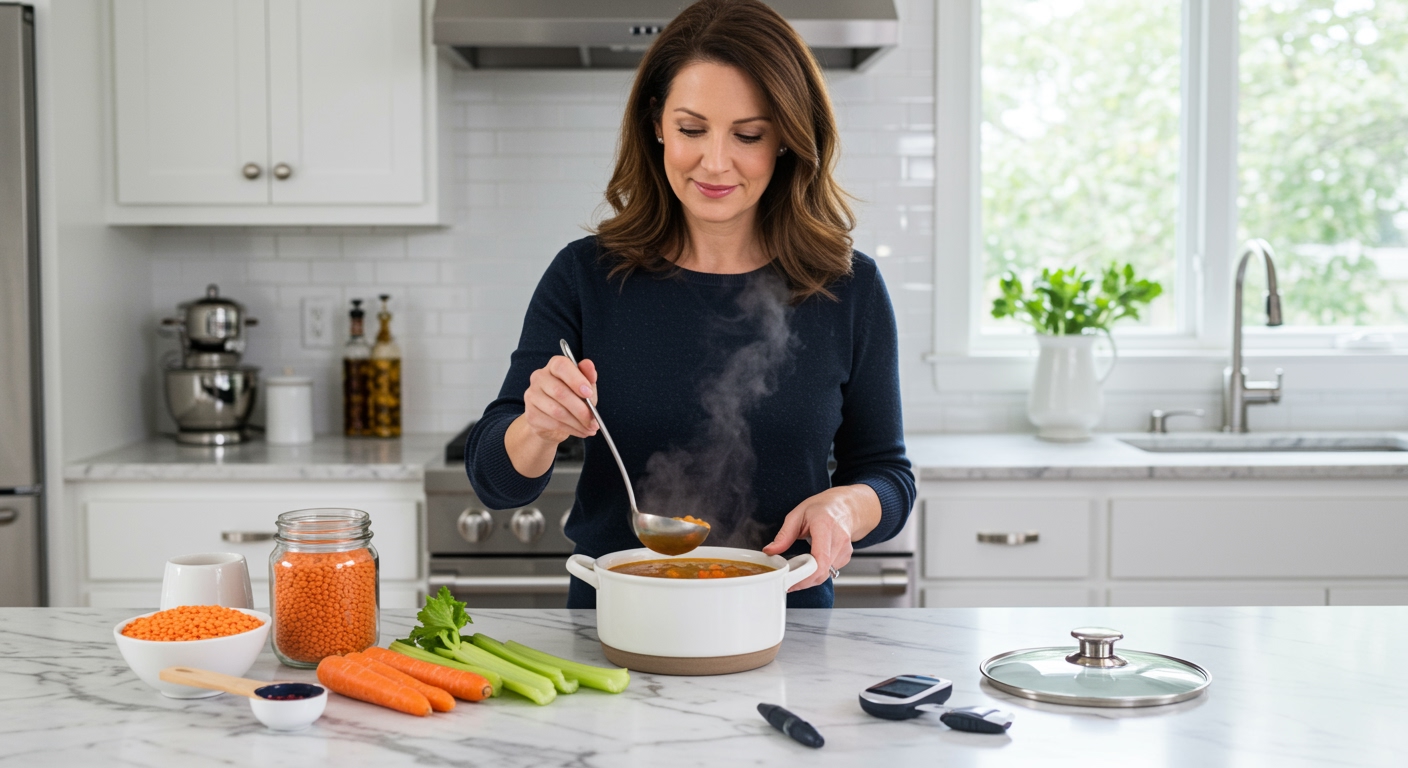✪ Key Takeaway: Lentil soup is excellent for diabetes because it has a low glycemic index and helps stabilize blood sugar levels.
Introduction
Your doctor just told you to watch your carbs, and now you stare at your favorite lentil soup wondering if it will send your blood sugar through the roof.
You might be asking this question because you love comfort foods but need to make smart choices for your health, or perhaps someone told you that all legumes are off-limits for diabetes management.
Hi, I am Abdur, your nutrition coach, and today I am going to explain exactly why lentil soup can be one of your best allies in managing blood sugar levels effectively.
What Makes Lentil Soup Different From Other Carbs?
Lentils have a glycemic index of just 25-30, which puts them in the low category compared to white bread at 75 or instant rice at 87.
This low glycemic index means your body digests lentils slowly, preventing the rapid blood sugar spikes that cause problems for people with diabetes.
The fiber content in lentils creates a gel-like substance in your digestive system that slows down carbohydrate absorption.
One cup of cooked lentils contains about 15 grams of fiber, which is more than half the daily recommended amount for most adults.
The protein content in lentils also helps stabilize blood sugar by slowing digestion and promoting satiety.
When you eat lentil soup, you get approximately 18 grams of protein per cup, which works together with fiber to create a steady energy release instead of quick spikes.
✪ Fact: Lentils contain resistant starch that feeds beneficial gut bacteria and improves insulin sensitivity.
How Does Lentil Soup Affect Your Blood Sugar Response?
Research shows that eating lentils can reduce your blood sugar response to other foods eaten at the same meal.
This phenomenon, called the second meal effect, means lentil soup at lunch can help control your blood sugar response at dinner too.
The complex carbohydrates in lentils take more energy to digest, which helps your body maintain better glucose control throughout the day.
Studies indicate that people with type 2 diabetes who regularly consume legumes like lentils show improved long-term blood sugar control measured by HbA1c levels.
The magnesium content in lentils supports insulin function, as this mineral plays a crucial role in glucose metabolism.
When your body has adequate magnesium, your cells respond better to insulin, making it easier to maintain stable blood sugar levels.
✪ Pro Tip: Add vegetables like carrots and celery to your lentil soup for extra fiber and nutrients without increasing the glycemic load.
Which Type Of Lentils Work Best For Blood Sugar Control?
Red lentils have the lowest glycemic index at around 25, making them the top choice for people managing diabetes.
Green and brown lentils follow closely with glycemic index values of 25-30, so any variety will provide excellent blood sugar benefits.
The cooking method matters more than the lentil type when it comes to blood sugar impact.
Overcooking lentils breaks down their cellular structure, which can slightly increase their glycemic response.
Cook your lentils until they are tender but still hold their shape for the best blood sugar control.
Adding healthy fats like olive oil or ingredients with natural acids like tomatoes can further slow down carbohydrate absorption from lentil soup.
✪ Note: Canned lentils are often softer and may have a slightly higher glycemic response than dried lentils you cook yourself.
What Should You Watch Out For When Making Lentil Soup?
Many commercial lentil soups contain added sugars, refined starches, or high sodium levels that can negatively impact blood sugar control.
Always check the ingredient list and choose products with simple, whole food ingredients or make your soup at home.
Portion size still matters even with low glycemic foods like lentils.
A reasonable serving of lentil soup is about one cup, which provides approximately 35-40 grams of total carbohydrates.
Adding high glycemic ingredients like white rice or refined pasta to your lentil soup will increase the overall glycemic load of the meal.
Stick to low glycemic additions like vegetables, herbs, and small amounts of whole grains if you want to maintain the blood sugar benefits.
✪ Pro Tip: Test your blood sugar 2 hours after eating lentil soup to see your individual response and adjust portions accordingly.
The Bottom Line
Lentil soup is not just good for diabetes – it is one of the best carbohydrate choices you can make for stable blood sugar control.
Smart food choices are not about restriction but about finding foods that work with your body instead of against it.
I would love to hear about your experience with lentil soup and blood sugar management, so please share your thoughts or questions in the comments below.
References
At NutritionCrown, we use quality and credible sources to ensure our content is accurate and trustworthy. Below are the sources referenced in creating this article:





